
My business partner reckons the system is Peter proof. If I can do it, anybody can.
Do it yourself with DRYROD the revolutionary new treatment for eradicating Rising (Salt) Damp. No liquids, no bottles, no mess, no smell. DRYROD damp-proofing rods are patented 12mm diameter grooved rods that carry a powerful water repellent material. They are simply inserted into 12mm holes in the mortar lines of a building. Once they are inserted, the rods will start to dry out the wall, the carrier rods will slowly diffuse water repellent deep into the damp masonry, curing to form a powerful barrier to further damp ingress. Tests have shown that DRYROD has much better diffusion characteristics than conventional damp-proofing products.
Installing DRYROD is extremely quick and easy. The step-by-step guide on this page outlines how to use DRYROD to damp-proof a standard brick wall. The same principles apply with thicker stone walls with random mortar courses simply by drilling in the lowest possible mortar course above ground level.
Required: Hammer Drill, 12mm Masonry Drill Bit, Tape Measure, Disposable Rubber Gloves
Other useful tools:Garden Secateurs
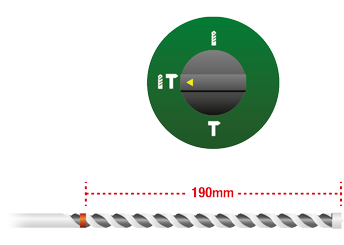
Mark your drill bit to the appropriate depth for the wall you wish to treat. A good quality 12mm Masonry Drill Bit is recommended for enhanced debris removal. Set your drill to rotary hammer mode and attach the suitably marked drill bit.
Identify the lowest horizontal mortar course that is accessible and continuous. Drill holes to the full recommended depth, at regular 120mm spacing along the wall. As the drill bit approaches the final 40mm of the intended hole depth, make sure to reduce the pressure you are putting on the drill. Excessive drilling pressure on the rotary hammer setting can result in damage to the far side of the wall.
Where the mortar is fully saturated, it may have begun to degrade, meaning that drilling dust can clump together and not clear the hole properly.
If this debris obstructs the insertion of the damp-proofing rods, re-drill the holes twice to remove any excess material.
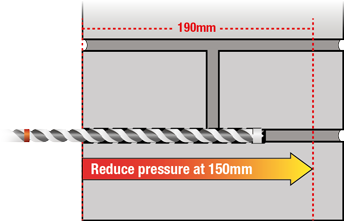
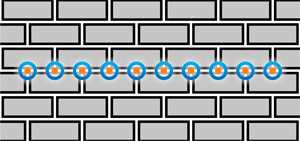
In stretcher bond construction the mortar joints fall at approximately 12cm intervals and can be used to quickly locate your drilling points.
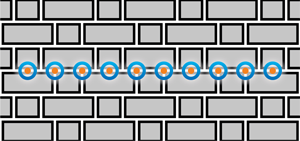
In flemish bond construction the vertical mortar joints either side of the smaller bricks and the mid point of the larger bricks lie at approximately 12cm intervals and can be used to locate your drilling points.

In irregular stone construction drilling points must be measured and care must be taken to make sure the line of the rods follow an unbroken line through the mortar at 12 cm intervals.
Wearing suitable gloves, remove the rods one by one from the packet and fully insert them into each hole. Ensure the rods are recessed approximately 5mm from the brick face, taking care not to compress the rod.
When installing internally, the performance of the rod will not be affected if the rods protrude slightly from the mortar, as a result of it being eroded at the surface. As long as the rod is inserted to the correct depth at the far side of the wall, full treatment will be accomplished and any protruding rods will be covered during redecoration.
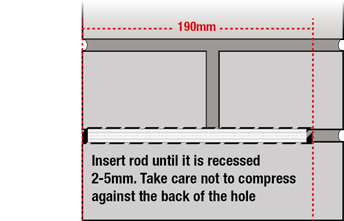
A standard DRYROD® Damp-Proofing Rod is 180mm in length, and will treat a double brick wall. See tables below for other wall thicknesses.

If the wall is thinner than 220mm then cut the rods down until they are 10mm shorter than the length of the hole

If the wall is thicker than 220mm, cut a second rod down till its length is 10mm less than the excess left after inserting one whole rod.

One Packet of 10 rods costs $60 including GST (less if you buy 5 packets or more) and will treat 2.5 meters of single brick which equates to less than $24 per metre, a saving of over $55 per metre compared to $80 per metre on average for professional application. Huge savings with little effort on your part. They are easy, clean and accurate to apply with no wastage. The only skill required is to be able to drill holes into a mortar course.